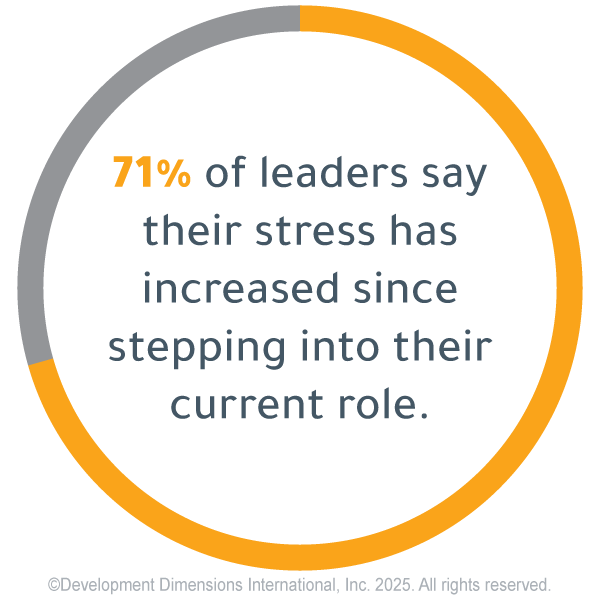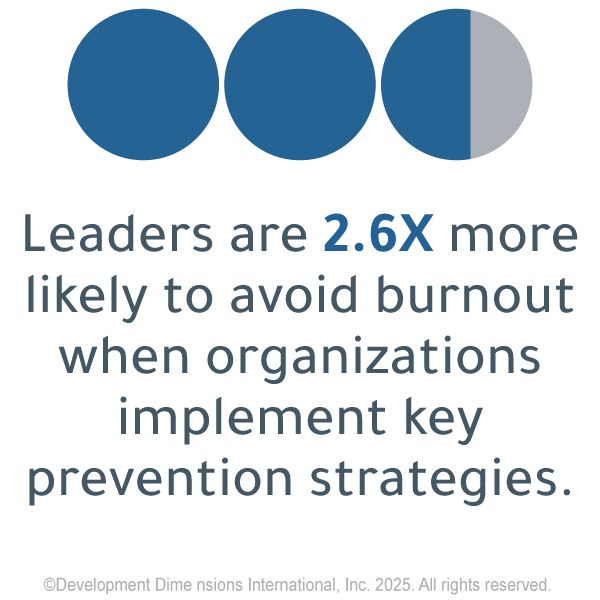
Burnout at work is not just a personal struggle—it’s an organizational crisis. Globally, 51% of employees reported feeling stressed “a lot of the day.” And stress among leaders is even higher. According to the Global Leadership Forecast 2025, 71% of leaders say their stress has increased since stepping into their current role.
Moreover, nearly one in six leaders worldwide experience burnout. Leaders in education, healthcare, and technology report the highest burnout rates among all industries.
When burnout is left unchecked, its effects can be severe. Stressed and burnt-out leaders are:
- 34% less effective than their peers.
- Half as likely to be engaged in their leadership role.
- 3.5X more likely to leave their position to improve their well-being.
With leader stress and burnout rising, organizations must proactively address the causes and take action to create healthier, more sustainable work practices. Ahead, we’ll discuss the key drivers of leader burnout as well as steps to prevent it and improve organizational resilience.
What Is Workplace Burnout?
Burnout is a work phenomenon that’s become so prevalent that the World Health Organization (WHO) declared it a syndrome that “refers specifically to phenomena in the occupational context…resulting from chronic workplace stress that has not been successfully managed.” The WHO took it one step further, stating that burnout “should not be applied to describe other areas of life.” Leaders experiencing burnout commonly report:
- Decision fatigue and difficulty concentrating.
- Longer work hours with lower productivity.
- Increased irritability and impatience with team members.
- Decreased enthusiasm and passion for previously engaging projects.
- Neglecting self-care and personal needs.
- Physical symptoms such as headaches, sleep disturbances, or digestive issues.
Burnout is deeply personal. Yet it stems from systemic workplace issues that organizations must address to prevent long-term damage to their leadership pipeline.
The Impact of Stress and Burnout
Leadership burnout is more than just an individual problem—it can silently erode an organization’s performance. When leaders face chronic stress and exhaustion, they struggle to make sound decisions, motivate their teams, and drive results. Over time, this can create ripple effects that undermine a company’s financial health, culture, and ability to retain talent.
Here’s how the impact shows up:
Performance Risk
Burnt-out leaders are 34% less likely to rate their effectiveness above their peers than those not experiencing burnout. **Why it matters: Less effective leaders miss chances, make bad choices, and cause slow progress that hurts profits.
Retention Risk
Stressed and burnt-out leaders are 3.5X more likely to leave their position to improve their well-being. **Why it matters: When leaders quit, workflow breaks down and puts stress on other leaders and teams.
Engagement Risk
Leaders who are burned out are half as likely to be engaged in their role as those who are not. **Why it matters: When leaders lose interest, it spreads to their teams, hurting morale and weakening work culture.
What Causes Leaders’ Stress and Burnout?
Leaders today face unprecedented challenges. Their roles are more complex, their responsibilities are growing, and the expectations placed on them continue to rise. While all leadership roles come with stress, research shows distinct workplace patterns that push leaders toward burnout. Three key factors are strongly linked to leader stress and burnout:

1. Lack of Time
Time scarcity is a critical issue for leaders. According to the Global Leadership Forecast 2025, only 30% of leaders feel they have sufficient time to do their job well. The pressure to perform without enough time leads to:
- Overwork: Leaders extend their work hours at an unsustainable pace, sacrificing their mental and physical well-being.
- Chronic frustration: The mismatch between time and workload creates stress, resentment, and exhaustion.
2. Resource and Information Constraints
Leaders often lack the tools and information they need. When this happens, they are twice as likely to be concerned about burnout. This challenge shows up in:
- Decision fatigue: Making high-stakes choices without complete information increases stress and cognitive overload.
- Lower perceived competence: Leaders who don’t have the right resources feel less confident in their abilities, a key factor in burnout.
3. Lack of Trust
Trust is the currency of any organization, yet it is alarmingly low. Only 29% of leaders trust their immediate managers, and 31% trust senior leaders. The impact is significant: leaders lacking trust in their direct managers are 3.2X more likely to be concerned about burnout. Those who distrust senior leadership face an even higher risk at 4.3X. Lack of trust significantly amplifies burnout risk through:
- Psychological insecurity: Leaders who don’t trust their organization’s direction remain in a state of heightened stress.
- Communication strain: Without trust, leaders must carefully filter their messaging, increasing emotional labor.
- Values conflict: Leaders may struggle to align with decisions they don’t believe in, creating moral distress.
How Do Work Arrangements Affect Leader Stress?
Work arrangements also influence leader stress and burnout, with different patterns emerging based on how and where leaders work.
Leader’s own work arrangement
Leaders who work onsite report higher stress levels (74%) than those who are hybrid (72%) or remote (66%). This is likely due to face-to-face interactions that create constant emotional management and direct exposure to workplace tensions. The in-person time also adds pressure to maintain a visible “leadership presence” throughout the day.

Interestingly, this trend reverses when examining burnout concerns. Hybrid and remote leaders report the highest levels of burnout, at 57% and 56% respectively, compared to 52% of in-person leaders. Hybrid and remote leaders often feel pressure to be “always on” or constantly digitally connected. They also face blurred boundaries between work and personal life and miss the casual social interactions that provide natural stress relief. In addition, these leaders tend to work extra hours to prove their productivity and offset their lack of visibility.
Alignment of manager and direct report work arrangement
Adding to these challenges, stress levels rise when a leader’s work arrangement differs from their manager’s. Of remote direct reports, those with an in-office manager are 2X more likely to be stressed than remote employees whose manager also works virtually. On the other hand, direct reports who work onsite but have a manager who works remotely are 1.4X more likely to be stressed than those whose manager is also onsite.
This pattern stems from communication gaps, mismatched expectations, and a lack of shared context. These challenges make it even harder to manage their workload. However, when both leaders and managers work remotely, they develop compatible approaches through similar communication rhythms and shared context. This alignment results in the lowest stress levels. Leadership relationships can, therefore, either amplify or mitigate the natural stress that comes with different work setups.
An Organization's Responsibility
These four key factors—time scarcity, resource constraints, lack of trust, and work arrangements—show that leader burnout isn’t simply a personal failure to manage stress. It’s a systemic problem that requires action. The data reveals distinct patterns of risk that organizations can address through thoughtful policy and cultural changes. When companies tackle these structural issues, they not only protect their leadership talent but also build a stronger, more resilient business. Preventing burnout isn’t just about teaching leaders to take breaks. It’s about creating work environments where leaders can maintain both their well-being and their effectiveness to drive organizational success.
5 Strategies to Prevent Leader Burnout
Preventing burnout requires organizational change, not just individual resilience.
Here’s how companies can proactively address burnout and build sustainable leadership cultures:

1. Strengthen leaders’ delegation skills.
Delegation is the most powerful skill for reducing leader burnout culture, according to DDI’s Global Leadership Forecast 2025. Based on data from 10,796 leaders, delegation is the most important skill in mitigating burnout (80%). This makes it five times more impactful than any other burnout mitigation skill. Leaders who struggle to delegate often become bottlenecks, carrying excessive workloads that lead to stress and exhaustion.
Effective delegation enables leaders to distribute responsibilities strategically, preventing the overwhelming pile-up of tasks that contribute to burnout. By entrusting team members with appropriate responsibilities, leaders reduce their own stress and foster team development and engagement. This shift transforms leadership from a solo, exhausting effort into a collaborative process.
And yet, according to DDI’s assessments of more than 70,000 manager candidates, only 19% are strong in delegation. Delegation is a complex skill that involves a blend of building trust, communicating clearly, and coaching each team member. It can be difficult to master, but it is critical for leaders’ success.
Many leaders struggle to delegate because they fear losing control or worry that passing work to others makes them look weak or inefficient. This skill gap often becomes apparent when professionals are promoted to leadership roles based solely on their strong technical expertise or high personal output. These new leaders struggle to transition from being highly effective “doers” to strategic “delegators.” It requires abandoning the very hands-on approach that earned them recognition in the first place.
Notably, delegation plays a far more significant role in avoiding burnout than another key skill: setting strategy. While strategic thinking is intellectually demanding, it represents only a tiny portion of many leaders’ responsibilities. In contrast, the daily pressures of workload management and interpersonal challenges are the primary drivers of burnout. And even well-crafted strategies can contribute to stress if leaders lack delegation skills to distribute work.


2. Improve leaders’ conflict resolution skills.
Unresolved workplace conflicts are a major stressor for leaders. Conflict resolution is the second most crucial factor to prevent burnout, carrying a relative importance of 15%. This shows that dealing with team tensions takes emotional labor and time, which meaningfully adds to leader stress.
Today’s work environment creates unique conflict challenges for leaders. Fast-paced work demands amplify tensions and leave little time for careful resolution.
Leaders often deal with specific types of team problems that wear them down: settling fights between team members, solving battles over resources, fixing disagreements about project goals, and handling stress from late work. These issues take a lot of emotional energy since leaders must remain neutral while supporting team harmony, often while handling their own stress and tasks.
Leaders who excel at effectively resolving conflicts are equipped with:
- Skills to de-escalate tensions before they become serious disruptions.
- Techniques to facilitate productive, solution-oriented discussions.
- The ability to foster a culture of psychological safety and open communication.
However, less than half of leaders—only 46% of more than 70,000 manager candidates—are proficient in this critical skill. As a result, many leaders experience the mental and emotional drain that comes from unresolved conflicts, along with the chain of problems that often follow. Leaders who address disagreements promptly and facilitate constructive solutions not only prevent these issues but also create a healthier, more collaborative work environment.

3. Build trust as the foundation of talent development.
Trust isn’t merely the byproduct of good leadership; it’s critical to prevent burnout. Trust is a two-way street, flowing from leaders to teams and back again. When leaders lack trust in their teams, they take on too much work themselves. And when teams don’t trust leaders, they push back and doubt them. This creates more emotional work and speeds up burnout. Trust enables delegation, reduces micromanagement, and fosters psychological safety. It also allows leaders to share responsibilities without constantly monitoring their teams.
While some leadership programs touch on trust, few make it a central focus, even though it matters so much. But leaders can learn and practice specific behaviors that build trust. Leaders can build trust by consistently practicing four key behaviors:
- Listen and respond with genuine empathy. Leaders who show they are genuinely listening and respond empathetically build deeper, more authentic connections with their team members.
- Encourage others to speak up without fear of reprisal. Creating a psychologically safe environment where employees feel safe to share ideas, concerns, and feedback is critical to building trust.
- Share thoughts and rationale for decisions. Transparent communication about why certain choices were made helps employees feel genuinely included and valued, enhancing trust.
- Encourage others to challenge old ways of doing things. Challenging existing paradigms fosters innovation and signals that leaders value improvement, driving both trust and creativity.

4. Ensure leaders have adequate resources.
Leaders need the right resources—including information, technology, and sufficient team capacity. Without adequate resources, leaders may resort to unsustainable practices, including personal sacrifices, to meet goals. This creates a direct pathway to burnout and eventual turnover. To provide leaders with what they need to be efficient and successful, organizations should:
- Identify and address resource gaps proactively.
- Prioritize high-leverage resources that address multiple stress points.
- Consider solutions like sharing resources across teams, automating routine tasks, or bringing in a temporary contractor during peak periods.
- Provide access to decision-making tools and support systems.

5. Cultivate a workplace culture that supports well-being.
Leaders can’t sustain performance in cultures that praise burnout as a badge of honor. Organizations that value late nights and weekend work create implicit pressure that wears down even the most resilient leaders. When leaders feel genuinely cared about, they reciprocate with greater engagement and loyalty.
To build a culture that supports leader well-being:
- Establish clear boundaries between work and personal time to prevent burnout.
- Align workloads with realistic capacity and strategic priorities to prevent chronic overwork.
- Normalize taking breaks and using vacation time. Make sure senior leaders model this balance.
- Consider how flexible work arrangements can support personal needs and preferences. Also, be aware that some work setups can inadvertently add stress for leaders.
- Recognize and reward leaders who foster sustainable workplace practices.
By making well-being a core company value, leaders can thrive without personal sacrifice. This cultural shift works to prevent burnout and drive more substantial business results through engaged and effective leaders.
Preventing Burnout Is a Business Imperative
Organizations that use these five key burnout prevention strategies see clear benefits. By focusing on delegation, conflict resolution, trust building, resource support, and positive culture, companies protect their leadership talent.

The numbers tell a powerful story. When these five strategies are in play, leaders are:
- 2.6X more likely to avoid burnout.
- 37.5X more likely to stay engaged.
- 18.5X more likely to enjoy leading.
- 11.8X more likely to remain with the company.
These results show why it’s crucial to prevent burnout. When companies invest in these areas, they build stronger teams and gain lasting advantages.
The message is clear: leader burnout can be prevented. When organizations focus on these proven strategies, they create places where leaders can thrive. This creates healthier leaders who stay longer, give more, and truly enjoy guiding others. And that’s essential to building a resilient, high-performing organization that thrives for years to come.
Have a Question?
FAQ
-
What are the signs of leadership burnout?
Signs of leadership burnout include chronic exhaustion, cynicism toward work, and a reduced sense of personal accomplishment. Leaders experiencing burnout may withdraw from their teams, have difficulty making decisions, and feel emotionally drained by everyday tasks. DDI’s leadership insights highlight these key warning signs as critical indicators that action is needed.
-
How can leaders prevent burnout among their teams?
According to DDI’s leadership development programs, leaders can prevent burnout by setting clear priorities, providing emotional support, encouraging open conversations about workload, recognizing contributions, and modeling a healthy work-life balance. Empowering teams and building emotional connections are essential skills that DDI emphasizes to help leaders maintain resilience across their organizations.
-
What strategies can organizations use to support burned-out employees?
DDI recommends that organizations support burned-out employees by building a culture of trust, investing in leadership development focused on emotional intelligence, offering flexible work arrangements, and providing coaching and mentorship opportunities. Through DDI’s leadership solutions, companies can equip leaders to identify stressors early and create sustainable environments for employee well-being.
-
How does DDI help companies address leadership burnout?
DDI helps companies address leadership burnout by delivering leadership development programs that strengthen emotional intelligence, resilience, coaching skills, and the ability to prioritize strategically. DDI’s proven leadership training solutions empower leaders to support their teams effectively while safeguarding their own mental health, ultimately creating more resilient, high-performing organizations.
Learn more about burnout in the Global Leadership Forecast 2025.
About the Authors
Stephanie Neal is director of the Center for Analytics and Behavioral Research (CABER). She leads market and trend research focused on leadership and business innovation and is the general manager and lead author of DDI's Global Leadership Forecast.
Rosey Rhyne is a senior research manager on DDI’s Center for Analytics and Behavioral Research (CABER) team, where she applies her background in I/O psychology and people analytics to better understand how to improve the leadership and employee experience.
Topics covered in this blog

